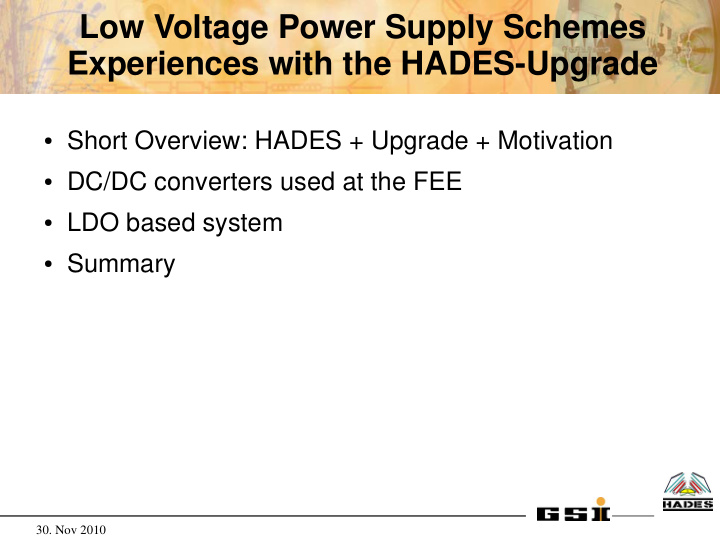



Low Voltage Power Supply Schemes Experiences with the HADES-Upgrade ● Short Overview: HADES + Upgrade + Motivation ● DC/DC converters used at the FEE ● LDO based system ● Summary 30. Nov 2010
High Acceptance DiElectron Spectrometer HADES Upgrade: DAQ 100.000 front-end channels ● 100 kHz event rate ● 400 MByte/s data rate ● 30. Nov 2010
DC/DC-Converters and Analog Electronics ● Paul Horowitz, Winfield Hill: The Art of Electronics (The Bible) + all experts ● Don't use DC/DC converters for analog electronics! ● This really motivates to try it out! 30. Nov 2010
Switcher vs. Linear Regulation DC/DC vs LDO: DC/DC vs LDO: ● Pro: ● More efficient for large Δ V and high currents ● Galvanic isolation is possible ● Cons: ● Produces noise: conduced and radiated ● Larger footprint depending on current ● More expensive 30. Nov 2010
DC/DC Market ● Point-of-Load Alliance: POLA ● multisourcing of pin-compatible, nonisolated, point- of-load power modules 30A output current 2.95-3.65V input voltage range Output voltages from 0.8V up to 2.5V Industry standard POLA™ compatible 34.8 x 28.5 x 9.00 mm High efficiency, up to. 93% ● Proprietary solutions: e.g.: μ Modules Auto Track™ sequencing pin More than 2.1 million hours MTBF 30. Nov 2010
Concept Common GND Galvanic isolation FEE 5V 5V 48V …... 48V To To Power Supply to xV xV 5V Detector Filters Analog Electronics ● 48V standard power distribution over larger distances ● 5V bus voltages on PCB ● Second DC/DC regulation at the point of load ● Filtering at the load 30. Nov 2010
First Application: 128 channel TDC ● DC/DC supplies and filters ● Down to 20ps time resolution ● FPGA-TDC: 10ps RMS time resolution (no tails) 30. Nov 2010
Filtering ● Pi-Filters: Low ESR Caps, Ferrite beads ● Second order: Common-Mode-Filters 30. Nov 2010
TOF ● TOF: 128 channel PMT discriminator and charge measurement ● ● Completely based on switchers on the same board ● No channels fire down to a sub 1mV threshold ● No change in performance if linear lab supplies are used as a reference! ● Conclusion: small common and differential noise on the PCB doesn't matter! ● PSRR value of modern OpAmps: 60-80dB (DC) 30. Nov 2010
RPC ● amplification (factor 100) + discrimination + charge measurement ● Distributed system with DC/DC separated and filtered ● No difference in performance between linear lab power supply and custom DC/DC solution could be measured 30. Nov 2010
Shower ● 96 channel ADC measurement ● Differential signal input ● DC/DC directly on board ● No noise floor on the ADC measurement 30. Nov 2010
RICH 30k channels ● pad-plane 700e noise ● DC/DC on ● FEE didn't work 50cm ● distance solved the issue completely 30. Nov 2010
Multiwire Drift Chamber 40k antennas ● Very sensitive to radiative noise => no DC/DC directly at the detector ● Huge effort to deal with linear regulators: heat, high currents, etc. ● 30. Nov 2010
MDC power-supply ● 8 times 180A power supplies, 1500W each 30. Nov 2010
Conclusion ● Horowitz, Hill: Are right and wrong at the same time! ● Conductive noise seems to be under control with “simple” filtering – Most of the FEE-electronics can be built with switchers ● Radiative noise is seen, if DC/DC is close to very sensitive detectors (like drift chamber antennas) – Distance (50cm) helps a lot (no noise measurable, on the 700e level) ● Your mileage may vary but it is worth a try – New low noise devices on the market every week – Hot topic 30. Nov 2010
Recommend
More recommend